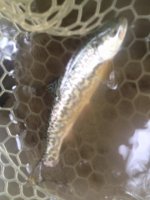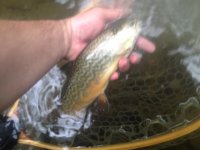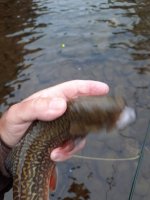As I commented last June…
“The stream that troutmeister most likely fished that’s a trib to the Ltl Schuylkill does in fact consistently produce the wild trout trifecta. It has even produced a large year class of golden rainbows in the past, but like the vast majority of streams that have a bit of RT reproduction at times, few if any fish make it to legal size. There is a second trib to the Ltl Sch R that could produce the trifecta in the past, but it was never surveyed enough to learn of any consistency.”
As others have said, the pictured fish is a wild tiger trout and the individual tribs within this basin support trout populations dominated by one species or the other, providing ample opportunity for stray gametes or direct cross breeding from sneaky (opportunistic), precocial, small trout that behaviorally would not normally get a chance to spawn. In Fisheries Behavioral Ecology they are referred to as cuckholders.
As an aside, cuckholdry occurs frequently among Bluegills as well, and they are the better known species for this behavior. Within Bluegill populations it is an undesirable trait in that it can contribute to stunting if genes related to early maturity are passed along within the population. Early maturity=slow growth and small size because energy that would normally go into production of somatic cells (muscle, bone, etc) goes into sex cell production instead. This is also the problem with overharvest of Bluegills, meaning cropping the population length distribution down to sizes less than about 7- 7.75 inches. With an abundance of large males over that size, small males in large part will not mature at an earlier life stage, keeping growth rates high(er) and the length distribution desirable for anglers.









